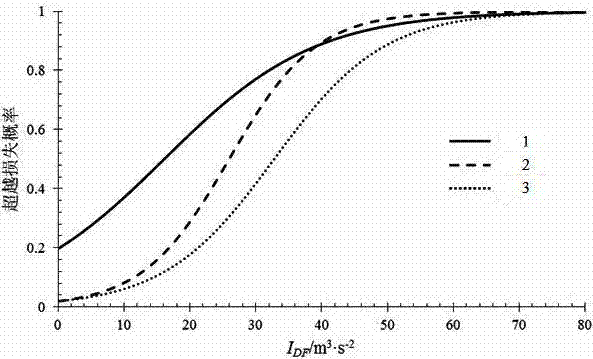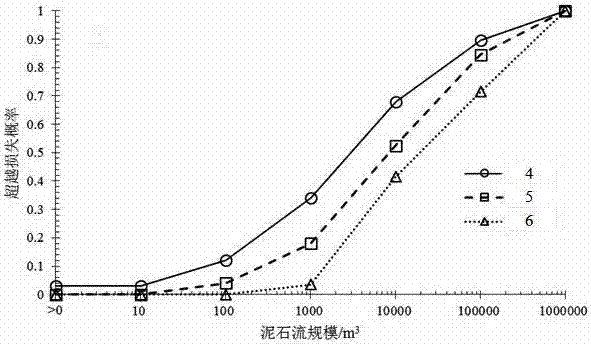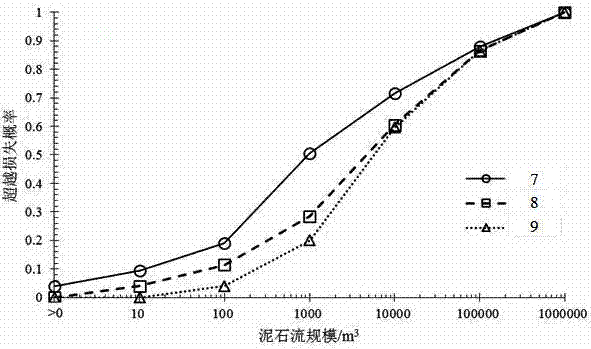A debris flow vulnerability calculating method
A calculation method and technology of debris flow, applied in the direction of calculation, design optimization/simulation, special data processing application, etc., can solve problems such as the correlation of debris flow intensity characteristics, inability to apply risk quantification research, etc., to achieve rapid and effective evaluation, improve applicability and The effect of accuracy
- Summary
- Abstract
- Description
- Claims
- Application Information
AI Technical Summary
Problems solved by technology
Method used
Image
Examples
Embodiment 1
[0034] A method for calculating debris flow vulnerability, comprising the following steps:
[0035] a. First obtain the debris flow intensity index I DF According to the distribution of typical buildings, by fitting the relationship between the intensity characteristics of debris flow and the damage survey data, a debris flow building vulnerability evaluation model suitable for strong earthquake areas is constructed;
[0036] b. Define typical disaster-affected objects, conduct on-site investigation and data collection, classify the building material and structure classification standards in the study area, and select the most severely disaster-affected building types as typical buildings according to the statistical results;
[0037] c. Divide typical building loss types into four grades. The first grade is mud and sand deposition, the second grade is partial structural damage, the third grade is main structural damage, and the fourth grade is complete damage. Debris Flow In...
Embodiment 2
[0043] A method for calculating debris flow vulnerability, comprising the following steps:
[0044] a. First obtain the debris flow intensity index I DF According to the distribution of typical buildings, by fitting the relationship between the intensity characteristics of debris flow and the damage survey data, a debris flow building vulnerability evaluation model suitable for strong earthquake areas is constructed;
[0045] b. Define typical disaster-affected objects, conduct on-site investigation and data collection, classify the building material and structure classification standards in the study area, and select the most severely disaster-affected building types as typical buildings according to the statistical results;
[0046] c. Divide typical building loss types into four grades. The first grade is mud and sand deposition, the second grade is partial structural damage, the third grade is main structural damage, and the fourth grade is complete damage. Debris Flow In...
Embodiment 3
[0052] A method for calculating debris flow vulnerability, comprising the following steps:
[0053] a. First obtain the debris flow intensity index I DF According to the distribution of typical buildings, by fitting the relationship between the intensity characteristics of debris flow and the damage survey data, a debris flow building vulnerability evaluation model suitable for strong earthquake areas is constructed;
[0054] b. Define typical disaster-affected objects, conduct on-site investigation and data collection, classify the building material and structure classification standards in the study area, and select the most severely disaster-affected building types as typical buildings according to the statistical results;
[0055] c. Divide typical building loss types into four grades. The first grade is mud and sand deposition, the second grade is partial structural damage, the third grade is main structural damage, and the fourth grade is complete damage. Debris Flow In...
PUM
 Login to View More
Login to View More Abstract
Description
Claims
Application Information
 Login to View More
Login to View More - R&D
- Intellectual Property
- Life Sciences
- Materials
- Tech Scout
- Unparalleled Data Quality
- Higher Quality Content
- 60% Fewer Hallucinations
Browse by: Latest US Patents, China's latest patents, Technical Efficacy Thesaurus, Application Domain, Technology Topic, Popular Technical Reports.
© 2025 PatSnap. All rights reserved.Legal|Privacy policy|Modern Slavery Act Transparency Statement|Sitemap|About US| Contact US: help@patsnap.com



